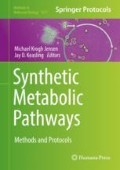Abstract
Adaptive laboratory evolution is a powerful technique for strain development. However, the target phenotypes using this strategy have been limited by the required coupling of the phenotype-of-interest with fitness or survival, and thus adaptive evolution is generally not used to improve product formation. If the desired product confers a benefit to the host, then adaptive evolution can be an effective approach to improve host productivity. In this book chapter, we describe an effective adaptive laboratory evolution strategy for improving product formation of carotenoids, a class of compounds with antioxidant potential, in the yeast Saccharomyces cerevisiae.
Access this chapter
Tax calculation will be finalised at checkout
Purchases are for personal use only
References
Reyes LH, Gomez JM, Kao KC (2014) Improving carotenoids production in yeast via adaptive laboratory evolution. Metab Eng 21:26–33. doi:10.1016/j.ymben.2013.11.002
Almario MP, Reyes LH, Kao KC (2013) Evolutionary engineering of Saccharomyces cerevisiae for enhanced tolerance to hydrolysates of lignocellulosic biomass. Biotechnol Bioeng 110(10):2616–2623. doi:10.1002/bit.24938
Reyes LH, Almario MP, Winkler J, Orozco MM, Kao KC (2012) Visualizing evolution in real time to determine the molecular mechanisms of n-butanol tolerance in Escherichia coli. Metab Eng 14(5):579–590. doi:10.1016/j.ymben.2012.05.002
Bentley WE, Mirjalili N, Andersen DC, Davis RH, Kompala DS (1990) Plasmid-encoded protein: the principal factor in the “metabolic burden” associated with recombinant bacteria. Biotechnol Bioeng 35(7):668–681. doi:10.1002/bit.260350704
Rozkov A, Avignone-Rossa CA, Ertl PF, Jones P, O’Kennedy RD, Smith JJ, Dale JW, Bushell ME (2004) Characterization of the metabolic burden on Escherichia coli DH1 cells imposed by the presence of a plasmid containing a gene therapy sequence. Biotechnol Bioeng 88(7):909–915. doi:10.1002/bit.20327
Verwaal R, Wang J, Meijnen JP, Visser H, Sandmann G, van den Berg JA, van Ooyen AJ (2007) High-level production of beta-carotene in Saccharomyces cerevisiae by successive transformation with carotenogenic genes from Xanthophyllomyces dendrorhous. Appl Environ Microbiol 73(13):4342–4350. doi:10.1128/AEM.02759-06
Li Q, Sun Z, Li J, Zhang Y (2013) Enhancing beta-carotene production in Saccharomyces cerevisiae by metabolic engineering. FEMS Microbiol Lett 345(2):94–101. doi:10.1111/1574-6968.12187
Xie W, Lv X, Ye L, Zhou P, Yu H (2015) Construction of lycopene-overproducing Saccharomyces cerevisiae by combining directed evolution and metabolic engineering. Metab Eng 30:69–78. doi:10.1016/j.ymben.2015.04.009
Nielsen J (2009) Systems biology of lipid metabolism: from yeast to human. FEBS Lett 583(24):3905–3913. doi:10.1016/j.febslet.2009.10.054
Xu X, Jin W, Jiang L, Xu Q, Li S, Zhang Z, Huang H (2016) A high-throughput screening method for identifying lycopene-overproducing E. coli strain based on an antioxidant capacity assay. Biochem Eng J 112:277–284. doi:10.1016/j.bej.2016.04.032
Wang TY, Tsai YH, Yu IZ, Chang TS (2016) Improving 3′-hydroxygenistein production in recombinant Pichia pastoris using periodic hydrogen peroxide-shocking strategy. J Microbiol Biotechnol 26(3):498–502. doi:10.4014/jmb.1509.09013
Kao KC, Sherlock G (2008) Molecular characterization of clonal interference during adaptive evolution in asexual populations of Saccharomyces cerevisiae. Nat Genet 40(12):1499–1504. doi:10.1038/ng.280
Bahler J, Wu JQ, Longtine MS, Shah NG, McKenzie A 3rd, Steever AB, Wach A, Philippsen P, Pringle JR (1998) Heterologous modules for efficient and versatile PCR-based gene targeting in Schizosaccharomyces pombe. Yeast 14(10):943–951. doi:10.1002/(SICI)1097-0061(199807)14:10<943::AID-YEA292>3.0.CO;2-Y
Winkler J, Reyes LH, Kao KC (2013) Adaptive laboratory evolution for strain engineering. Methods Mol Biol 985:211–222. doi:10.1007/978-1-62703-299-5_11
Boeke JD, LaCroute F, Fink GR (1984) A positive selection for mutants lacking orotidine-5′-phosphate decarboxylase activity in yeast: 5-fluoro-orotic acid resistance. Mol Gen Genet 197(2):345–346
Switala J, Loewen PC (2002) Diversity of properties among catalases. Arch Biochem Biophys 401(2):145–154. doi:10.1016/S0003-9861(02)00049-8
Martins D, English AM (2014) Catalase activity is stimulated by H2O2 in rich culture medium and is required for H2O2 resistance and adaptation in yeast. Redox Biol 2:308–313. doi:10.1016/j.redox.2013.12.019
Winkler JD, Garcia C, Olson M, Callaway E, Kao KC (2014) Evolved osmotolerant Escherichia coli mutants frequently exhibit defective N-acetylglucosamine catabolism and point mutations in cell shape-regulating protein MreB. Appl Environ Microbiol 80(12):3729–3740. doi:10.1128/AEM.00499-14
Breithaupt DE (2004) Simultaneous HPLC determination of carotenoids used as food coloring additives: applicability of accelerated solvent extraction. Food Chem 86(3):449–456. doi:10.1016/j.foodchem.2003.10.027
Kaiser P, Surmann P, Vallentin G, Fuhrmann H (2007) A small-scale method for quantitation of carotenoids in bacteria and yeasts. J Microbiol Methods 70(1):142–149. doi:10.1016/j.mimet.2007.04.004
Author information
Authors and Affiliations
Corresponding author
Editor information
Editors and Affiliations
Rights and permissions
Copyright information
© 2018 Springer Science+Business Media, LLC
About this protocol
Cite this protocol
Reyes, L.H., Kao, K.C. (2018). Growth-Coupled Carotenoids Production Using Adaptive Laboratory Evolution. In: Jensen, M.K., Keasling, J.D. (eds) Synthetic Metabolic Pathways. Methods in Molecular Biology, vol 1671. Humana Press, New York, NY. https://doi.org/10.1007/978-1-4939-7295-1_20
Download citation
DOI: https://doi.org/10.1007/978-1-4939-7295-1_20
Publisher Name: Humana Press, New York, NY
Print ISBN: 978-1-4939-7294-4
Online ISBN: 978-1-4939-7295-1
eBook Packages: Springer Protocols

